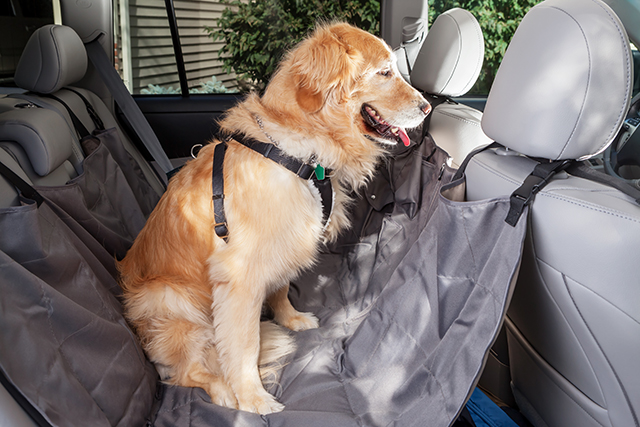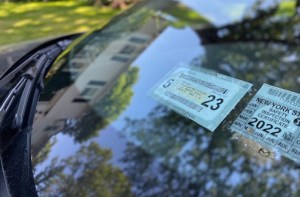It’s true: Home is wherever your pet is. The most recent statistics show that about 45% of households have dogs and 26% have cats, according to the American Veterinary Medical Association. While many pet owners like bringing their pets along on car trips, they may not be aware of cat or dog car restraint laws.
Laws on restraining pets differ from state to state, but it’s the invariable laws of physics that are most important when it comes to the safety of you and your pet. If a vehicle is traveling at 60 miles per hour, so are its passengers, and any unrestrained passenger (human or animal) becomes a projectile in a crash unless restrained. A 30-pound dog traveling at 60 miles per hour requires 1,800 pounds of restraining force, making it impossible to hold onto a pet to restrain them in your arms.
Pets can also easily become distractions in the car. Whether you’re taking them to the vet or a park or bringing them along for a hike or road trip, using pet restraints like dog car seats or seat belts help keep them safe in case of a crash and lower the chances they will disrupt your driving.
If you’re driving with your pet in the car, you should get to know your state’s restraint laws, as well as the laws of other states you may cross into.
Northeast Dog Car Restraint Laws by State
Connecticut
In Connecticut, distracted driving laws could be applied to drivers carrying their pet on their laps. When it comes to dogs being transported in an open truck bed, they must be contained in a crate or cage. This is a measure to prevent them from falling or jumping out of the vehicle.
Maine
For pickup trucks, convertibles and other open vehicles, Maine laws require some kind of dog car restraint in order to protect canines from being thrown from or trying to escape the automobile. Additionally, pets shouldn’t be carried on the driver’s lap. Violators can be charged under distracted driving laws.
Massachusetts
Again, dogs being transported in the bed of a truck must be safely secured, in either a cage or crate that is properly tethered to the vehicle. There are also height requirements for the sides and tailgate of a truck – they must be at least 46 inches high. Fines can start at $50.
In Massachusetts, laws also prohibit essentially anything that could interfere with a driver’s operation of their vehicle. Though the language is a bit vague, this law can prevent a dog from riding on the driver’s lap, sitting in the front seat or being unrestrained in the car.
New Hampshire
Similar to other states, dogs traveling in truck beds must be properly secured within a crate or cage that’s correctly cross tethered to the vehicle. New Hampshire laws also require certain heights for the sides and tailgate of the vehicle.
New Jersey
In New Jersey, carrying an animal in a cruel or inhumane manner can result in a fine. This kind of disorderly offense could cost a driver anywhere between $250 and $1,000 per offense. Using safety restraints can help protect your pet.
New York
Currently, New York does not have specific laws regarding how to properly restrain pets in the car. A bill prohibiting unrestrained animals in automobiles was first proposed in 2009 but has yet to pass in the state legislature.
Rhode Island
In Rhode Island, dogs traveling in a vehicle need to be secured in some way. This can include within a crate, restrained with a harness or dog car seat belt. Pets can also be under the physical control of a person other than the driver. Violators who don’t restrain their dogs can pay a fine up to $200 depending on the number of offenses.
Vermont
Vermont‘s laws regarding pet restraints are a bit more ambiguous. According to this state’s laws, animals cannot be transported in a cruel or inhumane manner. So safely securing your pet isn’t a bad idea in Vermont.
Approved Harnesses and Carriers
Some northeastern states have laws requiring dogs be restrained or secured while riding in a vehicle, while other states’ laws are a bit more vague. If you would rather err on the side of caution and opt to use some kind of pet restraint, there are many safe options to choose from.
The Center for Pet Safety approved several safety harnesses, including the Sleepypod Clickit Sport, Sleepypod Clickit Terrain and ZuGoPet Rocketeer Pack. Sleepypod’s full line of carriers is also CPS certified.
Kurgo products are designed for owners and dogs with an active lifestyle. They sell a variety of car products, like the crash-tested Car Safety Dog Harness and Seatbelt Tether.
Additional Pet Needs
When it comes to other pet needs on the road, be sure you have enough food, treats and water. A reflective leash and portable water bowl are helpful to have on hand, as well as a few toys. And finally, don’t leave home without your dog’s collar and ID tag(s).
If you’re taking your pet on a longer trip, check out these tips.
And did you know you can add your pet to your AAA membership? With the complimentary AAA Pet ID Tag Program, AAA can help reunite lost pets with their owners. It’s just another way we provide peace of mind to our members. Visit your local AAA branch to register your pet.
Do you drive with your pets? How do you keep them safe in the car? Tell us in the comments.
3 Thoughts on “What You Need to Know About Dog Car Restraints”
Leave A Comment
Comments are subject to moderation and may or may not be published at the editor’s discretion. Only comments that are relevant to the article and add value to the Your AAA community will be considered. Comments may be edited for clarity and length.















It is also important to note that dogs should never ride in the front seat of a car, even on the passenger side. In the event of an accident the airbag could kill them.
We have two toy poodles , 5 years old, that travel with us since they were babies. we have always strapped on each dog a harness that has a strap that goes through the seat belt & they ride in back seat. They each have a pink blanket they sit on.It’s second nature to them when we travel. Just like kids! They are too precious to us not to take their safety seriously.
I’ve got a very excitable 10 yr. old miniature poodle who loves to ride in the car. I’ve purchased a metal crate for her size with 3 doors that I secure to the back seat using the center seat belt running through the crate wall in the back to keep her safe.